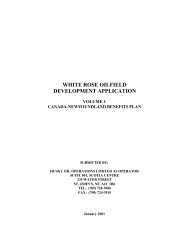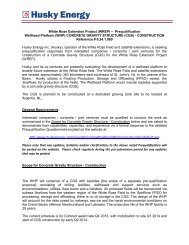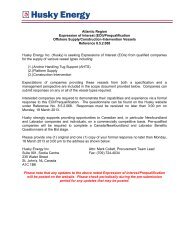white rose oilfield development application - Husky Energy
white rose oilfield development application - Husky Energy
white rose oilfield development application - Husky Energy
- No tags were found...
Create successful ePaper yourself
Turn your PDF publications into a flip-book with our unique Google optimized e-Paper software.
6.1.3.1 HousingThe number of dwellings in the province has grown considerably over the past 20 years. However, thenumber of annual housing starts has declined. In 1996, there were 185,500 occupied private dwellingsin Newfoundland, with most being owner-occupied, single-detached homes.In 1996, there were 60,295 occupied private dwellings in the St. John’s area, of which 61 percent werelocated within the City of St. John’s itself. Much of the growth in the region continues to occur inConception Bay South and Mount Pearl. Annual housing starts in the area have fluctuated over the lastdecade, with the general trend being one of decline. In recent years, the housing market, as reflected innumber and value of sales, has generally improved, and vacancy rates have fluctuated widely. Socialhousing in the St. John’s area is provided by the City of St. John’s and the Newfoundland and LabradorHousing Corporation.The total housing stock in the Isthmus Area increased by 26 percent between 1991 and 1996, with mostgrowth occurring in the Clarenville-Shoal Harbour area. In 1996, there were 3,895 occupied privatedwellings in the Marystown area, where the housing market is affected by the seasonal and annualfluctuations in employment by the main employers in the area.6.1.3.2 Ports and AirportsSt. John’s Harbour is administered by the St. John’s Port Corporation, a federal agency. There isapproximately 5 km of available dockface. Currently, the port serves as a container and roll-on/roll-off(RoRo) terminal for vessels carrying freight between Halifax and Montreal. The A.H. Harvey wharf isused by Hibernia and Terra Nova for shore-based marine services. Overall, the port has beenconsiderably underused in recent years, with traffic tonnage declining in the early 1990s. Cargo tonnagehandled has increased in recent years, with over one million tonnes of cargo being handled in 1999.The St. John’s International Airport is the busiest commercial airport in the province. The main terminalserves scheduled national and international passenger air traffic, most charter flights and air cargotraffic. Helicopter, military and private aircraft also use the airport. Over 800,000 commercialpassengers used the airport in 1999. In response to increased passenger demand and anticipated furtherincreases, the St. John’s Airport Authority is currently undertaking a $48 million re<strong>development</strong>program, including runway improvements and terminal building upgrading.White Rose DA Project Summary • January 2001 Page 88
















